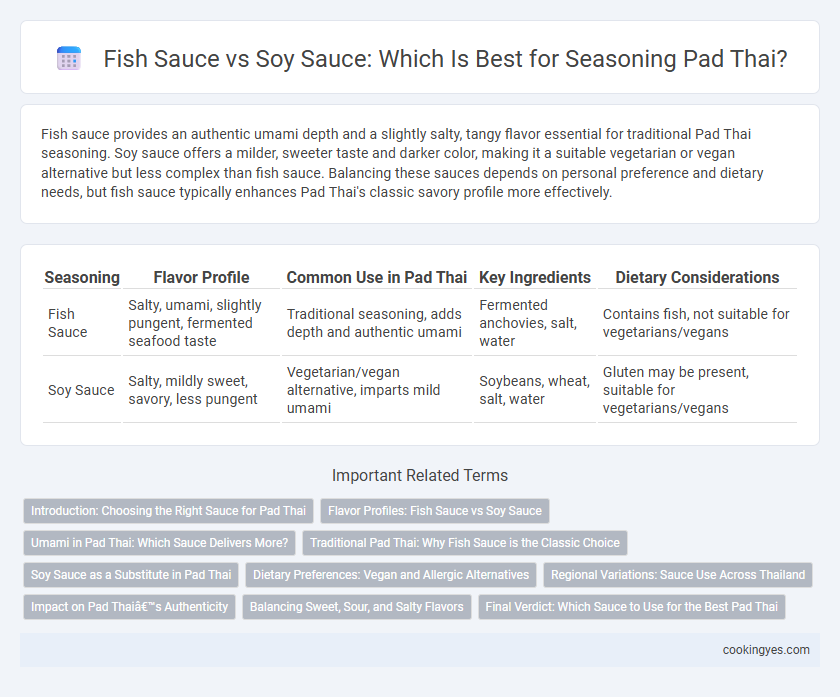Fish sauce provides an authentic umami depth and a slightly salty, tangy flavor essential for traditional Pad Thai seasoning. Soy sauce offers a milder, sweeter taste and darker color, making it a suitable vegetarian or vegan alternative but less complex than fish sauce. Balancing these sauces depends on personal preference and dietary needs, but fish sauce typically enhances Pad Thai's classic savory profile more effectively.
Table of Comparison
| Seasoning | Flavor Profile | Common Use in Pad Thai | Key Ingredients | Dietary Considerations |
|---|---|---|---|---|
| Fish Sauce | Salty, umami, slightly pungent, fermented seafood taste | Traditional seasoning, adds depth and authentic umami | Fermented anchovies, salt, water | Contains fish, not suitable for vegetarians/vegans |
| Soy Sauce | Salty, mildly sweet, savory, less pungent | Vegetarian/vegan alternative, imparts mild umami | Soybeans, wheat, salt, water | Gluten may be present, suitable for vegetarians/vegans |
Introduction: Choosing the Right Sauce for Pad Thai
Fish sauce delivers the iconic umami depth essential for authentic Pad Thai, enriching the dish with a salty, slightly sweet, and pungent flavor profile. Soy sauce, typically used as a substitute, adds a milder, less complex savory note but lacks the traditional tang and aroma that fish sauce provides. Selecting fish sauce over soy sauce ensures a genuine taste experience that aligns with classic Thai culinary standards.
Flavor Profiles: Fish Sauce vs Soy Sauce
Fish sauce offers a distinctive umami depth with a salty, slightly pungent aroma essential for authentic Pad Thai flavor. Soy sauce provides a milder, sweeter, and less briny taste, which can soften the overall dish's profile. Using fish sauce maintains traditional seasoning balance, while soy sauce creates a more subdued and less complex flavor experience.
Umami in Pad Thai: Which Sauce Delivers More?
Fish sauce dominates Pad Thai's umami profile with its rich, savory depth derived from fermented anchovies, enhancing the dish's authentic Thai flavor. Soy sauce provides a milder, slightly sweet umami, often balancing Pad Thai in vegetarian versions but lacking the complex seafood essence fish sauce offers. For true traditional umami intensity, fish sauce remains the preferred seasoning, delivering a bold, savory punch that defines classic Pad Thai.
Traditional Pad Thai: Why Fish Sauce is the Classic Choice
Fish sauce remains the classic choice for seasoning traditional Pad Thai due to its complex umami depth and authentic Thai flavor profile that soy sauce cannot replicate. Its fermented shrimp base imparts a distinctive savory tang essential for balancing the dish's sweet, sour, and spicy elements. Unlike soy sauce, fish sauce enhances the genuine taste of Pad Thai, preserving its cultural and culinary heritage.
Soy Sauce as a Substitute in Pad Thai
Soy sauce serves as a common substitute for fish sauce in Pad Thai, providing a salty umami flavor that complements the dish's balance of sweet, sour, and spicy elements. While traditional Pad Thai relies on fish sauce for its distinctive depth and aroma, soy sauce offers a vegetarian-friendly alternative without compromising taste. Using light soy sauce preserves the authentic seasoning profile, whereas dark soy sauce can add a deeper color and richer flavor to the stir-fry.
Dietary Preferences: Vegan and Allergic Alternatives
Fish sauce, a traditional ingredient in Pad Thai, is derived from fermented fish and is not suitable for vegans or those allergic to seafood. Soy sauce serves as a popular plant-based alternative, offering umami flavor while accommodating vegan diets and common seafood allergies. Choosing soy sauce enhances Pad Thai's accessibility without compromising its savory profile.
Regional Variations: Sauce Use Across Thailand
Northern Thailand traditionally favors soy sauce in Pad Thai seasoning, lending a milder and slightly sweeter profile to the dish. Central and Eastern regions predominantly use fish sauce, enhancing the Pad Thai with a savory umami depth characteristic of authentic Thai flavors. Southern Thailand blends both sauces, balancing saltiness and sweetness to reflect the area's diverse culinary influences and coastal heritage.
Impact on Pad Thai’s Authenticity
Fish sauce provides the essential umami depth and subtle saltiness that defines authentic Pad Thai flavor profiles, closely aligning with traditional Thai culinary practices. Soy sauce, often used as a substitute, imparts a sweeter and less complex taste, which can alter the dish's genuine balance and reduce its cultural authenticity. Incorporating fish sauce ensures the preservation of Pad Thai's characteristic savory notes and maintains its status as a classic Thai street food.
Balancing Sweet, Sour, and Salty Flavors
Fish sauce delivers a robust umami depth and salty kick essential to authentic Pad Thai, while soy sauce introduces a milder, slightly sweet saltiness that complements the dish's complexity. Balancing sweet tamarind and palm sugar with the pungent tang of fish sauce creates the signature harmony of flavors, whereas soy sauce may soften the sour notes, resulting in a subtler taste profile. Optimal seasoning depends on achieving equilibrium between salty, sweet, and sour elements to enhance the characteristic Pad Thai flavor without overpowering its natural ingredients.
Final Verdict: Which Sauce to Use for the Best Pad Thai
Fish sauce delivers the authentic umami and salty depth essential for traditional Pad Thai, enhancing the dish's balance of sweet, sour, and savory flavors. Soy sauce, while adding saltiness, lacks the complexity and pungent aroma imparted by fish sauce, often resulting in a milder taste profile. For the best Pad Thai experience, fish sauce is the preferred seasoning, providing the distinctive flavor that characterizes this beloved Thai street food.
Fish sauce vs soy sauce for seasoning Pad Thai Infographic

 cookingyes.com
cookingyes.com